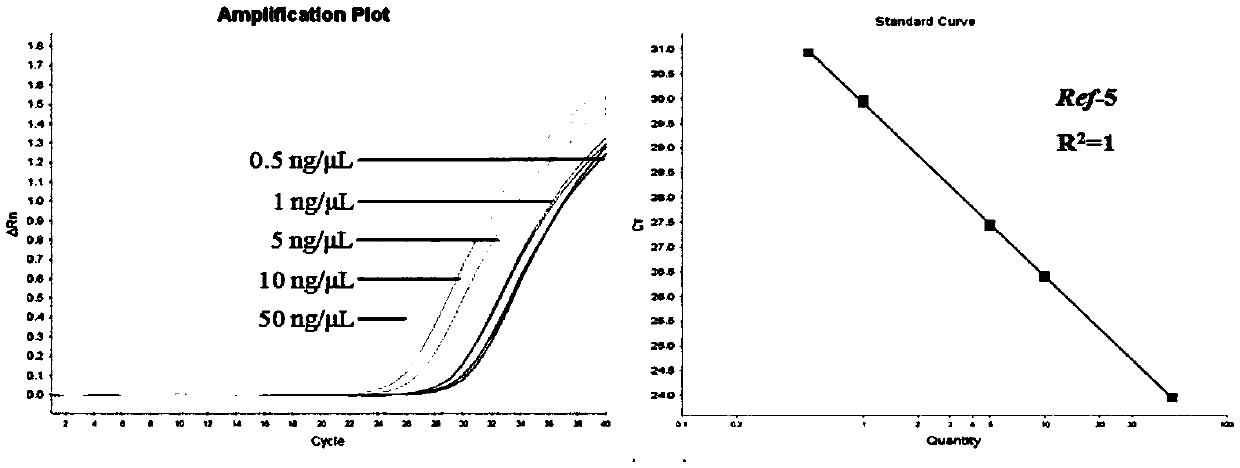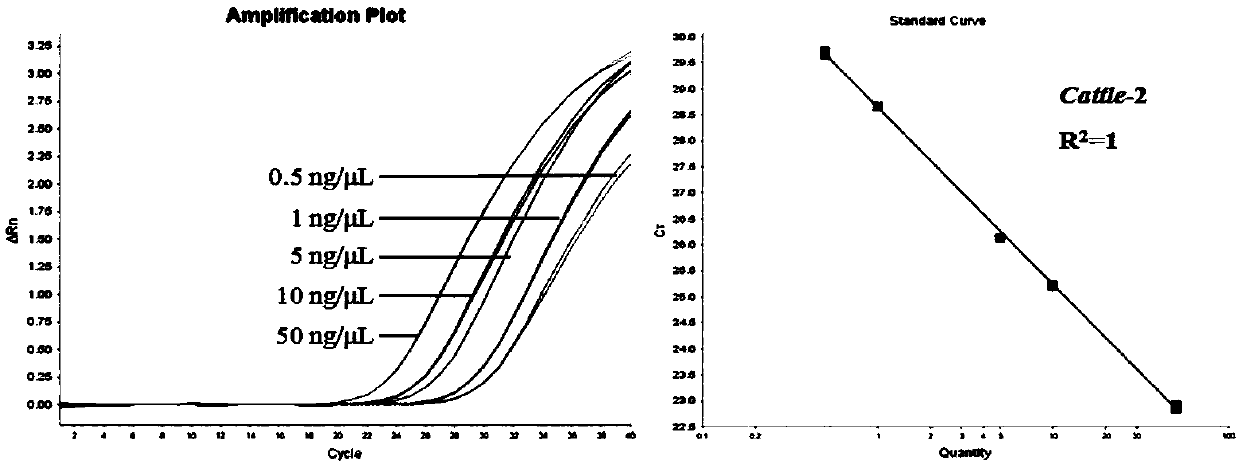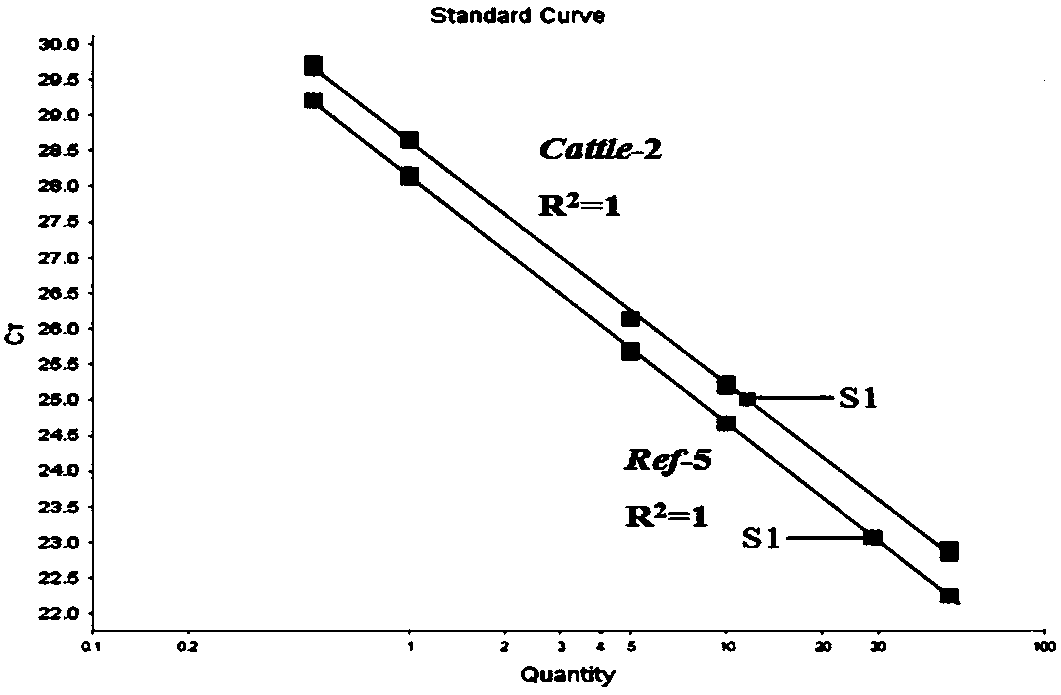Method for quantitatively detecting bovine-derived materials in livestock and poultry meat based on QPCR (quantitative polymerase chain reaction)
A bovine-derived, content-based technology, applied in the field of molecular biology analysis, can solve problems such as cumbersome operations, long time-consuming, and inability to quantify the content of heterologous animal components
- Summary
- Abstract
- Description
- Claims
- Application Information
AI Technical Summary
Problems solved by technology
Method used
Image
Examples
Embodiment 1
[0044] (1) Sample S1: a homemade simulated mixed sample with 30% bovine-derived components, in a mixing method of 30g beef + 70g pork.
[0045] (2) Reagents: Premix Ex Taq (Probe qPCR) premix solution produced by TaKaRa company; internal reference gene and bovine species-specific gene amplification primers and probes synthesized by Shanghai Shenggong.
[0046] (3) Sample DNA extraction: SDS-silica gel column modified method extraction (see attachment).
[0047] (4) Amplification reaction system and amplification procedure: The total volume of the amplification reaction is 20 μL, and its various components are: 20 μL of 2×Premix Ex Taq (Probe qPCR) premix, 1 μL of 10 μmol / L upstream and downstream primers, 10 μmol / L probe primer 0.4 μL, template DNA 1 μL (template DNA concentration 50 ng / μL), make up to 20 μL with sterilized deionized water; Reaction program: denaturation at 95 °C for 5 min; carry out 45 cycles of amplification reaction (95 °C Denaturation for 15s, annealing a...
Embodiment 2
[0059] (1) Sample S2: a homemade simulated mixed sample with 70% bovine-derived components, in a mixing method of 70g beef + 30g chicken.
[0060] (2) Reagents: Premix Ex Taq (Probe qPCR) premix solution produced by TaKaRa company; internal reference gene and exogenous species-specific gene amplification primers and probes synthesized by Shanghai Shenggong.
[0061] (3) Sample DNA extraction: SDS-silica gel column modified method extraction (see attachment).
[0062] (4) Amplification reaction system and amplification procedure: The total volume of the amplification reaction is 20 μL, and its various components are: 20 μL of 2×Premix Ex Taq (Probe qPCR) premix, 1 μL of 10 μmol / L upstream and downstream primers, 10 μmol / L probe primer 0.4 μL, template DNA 1 μL (template DNA concentration 50 ng / μL), make up to 20 μL with sterilized deionized water; Reaction program: denaturation at 95 °C for 5 min; carry out 45 cycles of amplification reaction (95 °C Denaturation for 15s, annea...
Embodiment 3
[0074] (1) Sample S3: a homemade simulated mixed sample with 70% bovine-derived components, in a mixing method of 70g beef + 30g duck.
[0075] (2) Reagents: Premix Ex Taq (Probe qPCR) premix solution produced by TaKaRa company; internal reference gene and exogenous species-specific gene amplification primers and probes synthesized by Shanghai Shenggong.
[0076] (3) Sample DNA extraction: SDS-silica gel column modified method extraction (see attachment).
[0077] (4) Amplification reaction system and amplification procedure: The total volume of the amplification reaction is 20 μL, and its various components are: 20 μL of 2×Premix Ex Taq (Probe qPCR) premix, 1 μL of 10 μmol / L upstream and downstream primers, 10 μmol / L probe primer 0.4 μL, template DNA 1 μL (template DNA concentration 50 ng / μL), make up to 20 μL with sterilized deionized water; Reaction program: denaturation at 95 °C for 5 min; carry out 45 cycles of amplification reaction (95 °C Denaturation for 15s, annealin...
PUM
 Login to View More
Login to View More Abstract
Description
Claims
Application Information
 Login to View More
Login to View More - R&D
- Intellectual Property
- Life Sciences
- Materials
- Tech Scout
- Unparalleled Data Quality
- Higher Quality Content
- 60% Fewer Hallucinations
Browse by: Latest US Patents, China's latest patents, Technical Efficacy Thesaurus, Application Domain, Technology Topic, Popular Technical Reports.
© 2025 PatSnap. All rights reserved.Legal|Privacy policy|Modern Slavery Act Transparency Statement|Sitemap|About US| Contact US: help@patsnap.com



